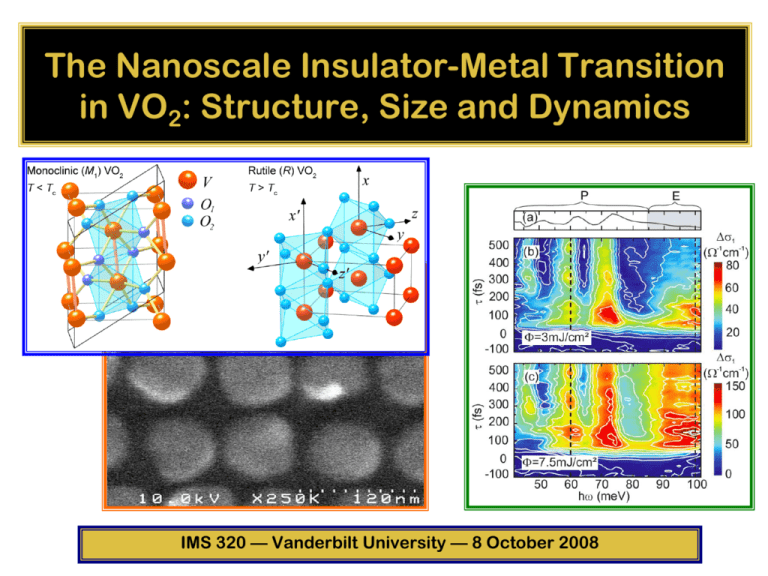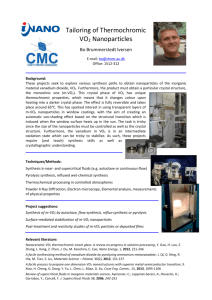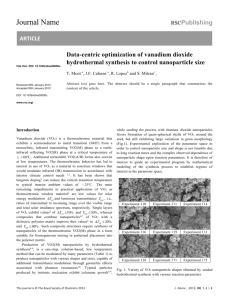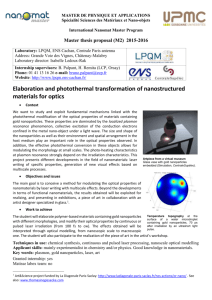ims-320-lecture-10-8-08
advertisement

The Nanoscale Insulator-Metal Transition in VO2: Structure, Size and Dynamics IMS 320 — Vanderbilt University — 8 October 2008 Egyptian Materials Research Society Slide 1 What you are about to hear … • Motivation: exploiting the metal-insulator transition o Highly correlated solids and the phase transition o Smart or functional nanoparticles o Nanoscale properties of metal oxides • Fabrication of VO nanoparticles • Optical properties of VO nanoparticles • Dynamics of the metal-insulator transition • What have we learned, and where are we going? 2 2 2 37 … strongly correlated electrons Itinerant electrons (Fermi liquid) CORRELATED ELECTRONS Tradeoff between hopping rate tij (kinetic energy) and Hubbard U (on-site Coulomb potential) Localized electrons (Mott insulator) 3 37 Kotliar and Volllhardt, Physics Today, March 2004 for review of DMFT VO2 metal-insulator transition • Morin, PRL, 1959 • First-order phase transition • Structural rearrangement • Gives D(conductivity)~10 -10 • Large change in optical T, R • Can be triggered by laser • Entropy cost DS~1.6k /V ion • Antiferromagnetic above T 4 5 B C 4 37 Hysteresis loop; typical first order transition feature. Temperature dependence of resistivity in VO2 films VOx focal-plane array bolometers • • • • 5 37 Vox bolometers are being developed for use in uncooled focal-plane IR detectors (8-14 µm). Small size is critical, since it sets the spatial resolution of the focal-plane array given camera parameters Little is known about the effects of granularity, stoichiometry and other materials parameters on detector performance (noise limits, etc.) Photo credits: Raytheon Corporation VO2: a martensitic phase transition Structural phase transition alongside SMT: T < Tc monoclinic T > Tc rutile (tetragonal) Monoclinic phase: pairing and tilting of V cations doubling of unit cell One valence electron per V cation 3d compound narrow bands e-e correlations Which comes first, lattice change or SMT? 37 Mechanisms of metal-insulator transition Dimerization of atoms unit-cell doubling Opening of new band gap at Fermi level metal-insulator transition Peierls deformation lowering of electronic energy (mostly near kF) vs. increase in elastic energy Quasi-1D metals (e.g., VO2) susceptible to Peierls instability 37 Hubbard U: Coulomb repulsion between on-site electrons energy “penalty” for electron transport Bandwidth W: determined by hopping between sites kinetic energy of electrons U ~ W itinerant vs. localized behavior Mott metal-insulator transition Narrow-band systems (e.g., VO2) strong electron-electron correlations . First-order thermodynamics and hysteresis First-order phase transformation: discontinuous first derivatives of Gibbs free Avalanche-mediated transformation path: energy athermal activation thermal fluctuations entropy change latent heat of transformation not operative need for undercooling and overheating very recently observed in VO2 hysteresis around Tc nanojunctions Generic bistable potential linear tilt controlled by driving field h (e.g., |T – Tc|) 37 What you are about to hear … • Motivation: exploit the metal-insulator transition • Fabrication of VO nanoparticles 2 o Ion implantation in bare SiO2 substrates o Pulsed laser deposition of V in O2 atmosphere o Fabricating nanoparticle arrays of VO2 • Optical properties of VO nanoparticles • Dynamics of the metal-insulator transition • What have we learned, where are we going? 2 9 37 nc-VO2 by ion implantation Ion acceleration Ion separation magnet Electrostatic Deflection (Rastering) Target Ion extraction O @ 55 keV, 3.0 x 1017 ions/cm2 V @ 150 keV, 1.5 x 1017 ions/cm2 Ion source Anneal 1000 ºC C-axis 10 37 Fabrication of Au::VO2 nanostructures • VO film by PLD • Stoichiometry by RBS • Switching by T (IR) • Morphology by SEM • Location by microscopy 2 opt 37 Long anneal times Reflection (A.U.) 80 70 60 50 40 30 20 10 0 40 minutes 0 Reflections (A.U.) 80 70 60 50 40 30 20 10 0 20 40 60 80 100 80 100 80 minutes 0 20 40 60 Temperature (C) • Hysteresis width and transition temperatures correlate with increasing nanocrystal size to Tanneal~450˚C 37 VO2 vs V2O5 growth t=15 nm, T=450˚C, 250 mTorr O2, 40 min 2.00 µm 1.00 µm t=15 nm, T=550˚C, 250 mTorr O2, 40 min 2.00 µm • • • 37 1.00 µm VO2 NCs are hemispherical, implying no wetting of the Si substrate X-ray data confirm that 550˚C anneal produces substantial V2O5 Shape of high-temperature anneal NCs shows surface wetting What you are about to hear … • Motivation: exploit the metal-insulator transition • Fabrication of VO nanoparticles • Optical properties of VO nanoparticles 2 2 o Measuring the optical response of nanoparticles o Making valid comparisons for varying NP sizes o From characterization to modeling • Dynamics of the metal-insulator transition • What have we learned, where are we going? 14 37 Transmission experiments 15 37 • Broadband white-light source • CCD spectrometer (0.3-1.2 µm) • Measure transmission vs temperature Optical response vs size 1.05 l=2.0 µm 1 Transmission 0.95 0.9 2 min Increasing VO2 size 0.85 0.8 Reff 37 nm b/a 1.3 67 nm 80 nm 89 nm 87 nm 1.9 2.7 3.2 3.5 5 min 9 min 15 min 20 min 0.75 60 min 0.7 0.65 0.6 20 25 30 35 40 45 50 55 60 65 70 75 80 85 Temperature (°C) V, 1.5 x 1017 ions/cm2 O, 3.0 x 1017 ions/cm2 Anneal in Ar 1000 ºC 16 37 Nanoparticles by ion implantation Lopez et al., Phys. Rev. B (2002) Nucleation and size-dependence of hysteresis Lopez et al., Phys. Rev. B 65, 224113 (2002) Energy barrier too high for homogeneous nucleation VO2 transition nucleates at heterogeneous “potent sites” Availability F of potent sites depends on: nanoparticle volume V thermal driving “force” |T – Tc| Smaller NPs larger driving force needed to transform wider hysteresis 37 Heterogeneous nucleation • Nucleation at special sites (structural or point defects?). • Not all defects have the same potency to nucleate the transition. • This potency must be thermally activated IF : o The probability of finding an activated defect in a DV is DV o The probability of finding more than 1 defect in that DV is negligible; o The probability of finding that defect is independent of other DV’s; o Then Poisson statistics apply, and ... 18 37 Density of defects is C Dgex T Tc y Defect probability is F 1 exp V Optical signature of nucleation 1 r e T 4 2 Nz 1 r e 2 2 Nz 1 Switching 0.8 T 0.6 Th Tc 0.4 0.2 0 25 35 45 55 65 Temperature (ºC) No h z Th e 19 37 No c z , Tc e e Nz c h 1 75 ( No N ) h zN c z , T e N z c h N T Th F N z N o z c h N o Tc Th e o c h 1 Size dependence of MIT 20 37 Remember: Small is different! (“Small” depends on property.) 29 June 2007 Rice University ECE Seminar nc VO2 arrays 21 37 • Remove VO -coated x PMMA by standard lift-off technique Anneal in 250 mTorr O2 at 450C for up to 30 min. • o RESULT: VO2 nanoarrays o Limited by PMMA thickness nc-VO2, typical disk diameter 60 nm, height variable, spacing variable. … and it is size-dependent • Measured scattered (white) light, dispersed in CCD spectrometer • VO nanoparticles 120 nm diam • Lattice constant 280 nm • Resonance at 460 nm • Double hysteresis loop 2 22 37 500 nm An order-disorder transition -4 warming up Log(-ln(1-F) / V) -4.5 Cooling down -5 -5.5 y = 2.0461x - 10.053 R2 = 0.989 -6 -6.5 -7 y = 3.0456x - 13.164 R2 = 0.9388 -7.5 -8 1 1.5 2 2.5 3 Log Dgex (J/mole) 23 37 • Note that the differing widths of the “bumps” parallels the differing Dgex dependence of heating and cooling transitions! What you are about to hear … • Motivation: exploit the metal-insulator transition • Fabrication of VO nanoparticles • Optical properties of VO nanoparticles • Dynamics of the metal-insulator transition • Appearance of a metallic plasmon response • THz probe of AC conductivity • A model supporting recent theory • What have we learned, where are we going? 2 2 24 37 fs response of VO2 films and nc-VO2 • fs pump at 800 nm, fs IR • probe LSPR response as in adiabatic thermal phase transition Lopez et al., Applied Physics Letters (2004) M. Rini, R. Lopez, A Cavalleri et al., Optics Letters (2005) 37 Ultrabroadband THz study of VO2 Nd:YVO4, 18 W VD2 VD1 T tD 4 MHz Ti:sapph amplifier tp = 12 fs; Ephot = 1.55 eV Opt. Lett. 28, 2118 (2003) EOX GaS e 37 WP l/4 balanced differential detector: ETHz(T), DETHz(T, tD) electro-optic analysis of both transmitted THz amplitude and phase i-InP, d = 230 nm VO2, d = 100 nm Integrated THz response 37 Two-dimensional spectra 37 Coherent phonon generation 37 Model developed from THz experiments 37 What you are about to hear … • Motivation: exploit the metal-insulator transition • Fabrication of VO nanoparticles • Optical properties of VO nanoparticles • Dynamics of the metal-insulator transition • What have we learned, where are we going? 2 2 o Novel geometries, stress and strain o Better materials and shorter pulses o Modeling the electric field effects 31 37 One more variation on geometry Probe laser Heating laser Glass VO2 film • SiO microspheres on glass by micropipette • Monolayer polycrystalline colloidal film • Microsphere diameter 1.54 µm in all cases • Laser heating and laser probing during MIT 2 37 Transmission measurements VO2 thin film samples VO2 film on SiO2 µspheres 100 nm on SiO2 100 nm film 140 nm on SiO2 140 nm film • Samples heated by ns Nd:YAG laser (532 nm) • Heating fluence ~ 10 mJ/cm • Transmission measured at 980 nm (cw diode) • Transmission on µsphere array increases! 2 37 So what is happening … and why? • The µsphere array is a diffraction grating … • … with light in both zeroth and first orders. • Measurement shows that MIT shifts intensity … • … from first to zeroth order in µsphere array. • It could be stress! • Epi-VO on TiO2 shows that Tc shifts higher with increasing stress (thinner films?) 2 37 Tc~82˚C Tc~72˚C Materials, geometries … nanophotonics • Oriented nanostructures • Better material(epi-VO ) • Exploit optical near field • Nonlinear optics (SHG, 3) • Other correlated materials? 2 37 What is to learn? • New materials and nanoscale structures o Materials: V2O3, VxCr1-xO2, WO3, … o Novel structures (e.g., arrays with curved surfaces, Konstanz) o Embedding materials designed for particular effects (e.g., NLO) • Ultrafast and angle-resolved studies of the effect: o Switching nonlinear effects using ultrashort laser pulses o Exploring the wavelength- and surface-dependence o What about the effect of the VO2 SPR (~1.3 µm)? • Ultrafast, THz and FIR studies o THz radiation could look at properties of the excited electron gas o FIR spectroscopy could help resolve controversial Raman results. o Early fs THz studies hint at MIT-related IR modes (Konstanz) • Nanoscale geometrical structure brings advantages of optical coherence to nanoscale differences! 37 The end … Picasso “Don Quixote” (in VO2) 2.31 µm “The legitimate purpose of research can only be, to make two questions grow where there was only one before.” [Thorsten Veblen] Jae Suh René Lopez Matthew McMahon Eugene Donev Thanks to the National Science Foundation and the United States Department of Energy for $$$! 37






